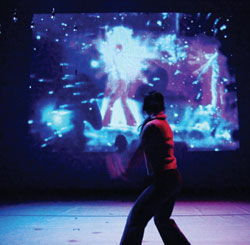Concordia Corner
Welcome to the holodeck, Captain

The Black Box represents a balance of art and science dressed up with dazzling effects.
Photo by Rob Maguire
Walking into the Black Box, you get the impression that anything can happen here … and it does.
The room is huge, about three storeys cubed. And it’s dark, entirely black except for a grey grid on the floor and a movie-theatre-sized screen on the west wall. Projected on the screen is a static field of digital stars against an electronic night sky. About a dozen people scurried around, eyes accustomed to the dim light, getting ready for a dress rehearsal.
“Step onto the floor,” Sha Xin Wei invited, “This is what it’s all about.” Sha is the Canada Research Chair in Media Arts and Sciences. Shadowy outlines of our bodies appeared on the screen, amid the stars.
“Move,” Sha prompted, and as soon as we did, the stars were in flight, drawn to our e-shadows like magnets. All around, a strange symphony of sound played in harmony with the motion on the screen. It was remarkably compelling.
“It’s called Meteor Shower,” Sha explained later. It’s an example of what he calls responsive media – visual or sonic textures that evolve and change in concert with how people move. Meteor Shower is also just one of the ways that Sha and his students (undergrads Jean Sébastien Rousseau, Louis-André Fortin, Tim Sutton and Emmanuel Thivierge) are exploring how to make the ordinary extraordinary.
“Ultimately, we want to see if people can create a bit of marvel in their everyday experience as we figure out how to build responsive media in public and domestic spaces.”
For Sha, the Black Box is a lab, a protected space for creating and incubating what we may one day experience in our parks or our homes. “Here we get to build the media and figure out the really difficult engineering answers to how you get installations like Meteor Shower to last outside with the wind and the rain.”
But the Black Box is much more than a lab. It’s also a dance studio, a theatre, a warehouse, a meeting place. As Sha pointed out, it isn’t actually any of these things without some help. “Essentially, it’s a tabula rasa. Anyone who goes in can make it what they need it to be.”
The room needs complementary equipment to meet specific needs. So for Meteor Shower to work, Sha moved computers and wiring down from his Topological Media Lab in another section of the EV Building.
The Black Box is just one of the facilities built with a $21-million Canadian Foundation for Innovation (CFI) grant awarded to Hexagram, the Institute for Research, Creation in Media Arts and Technologies. Funding will also contribute to the construction of an identical facility at UQAM. The two boxes will eventually be linked by a high speed Internet line that will allow for collaborative work at a distance.
While the 75 artist-researchers at Concordia and UQAM who are members of Hexagram have priority for booking the space, Black Box Coordinator Mark Baehr pointed out that it is a community facility available to all faculty and graduate students who can make use of the space’s huge potential.